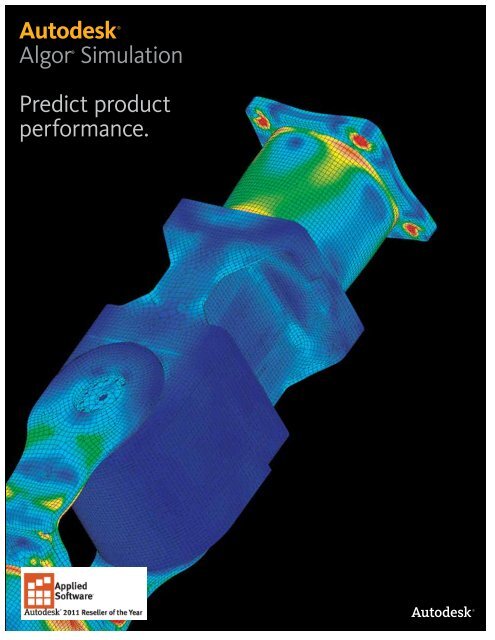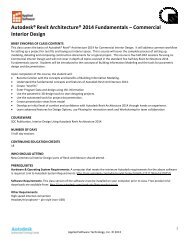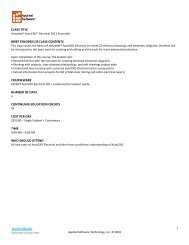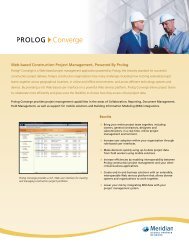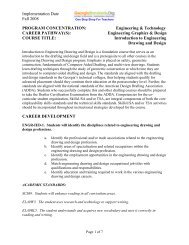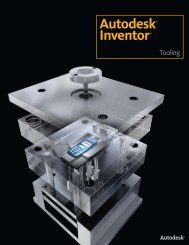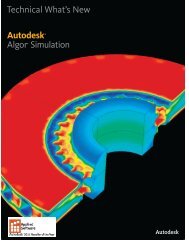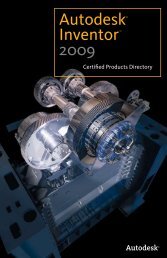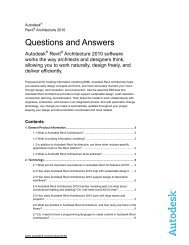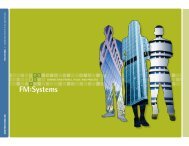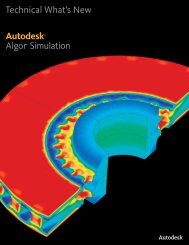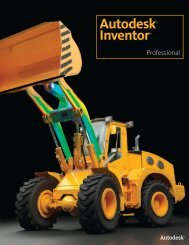AutoCAD Inventor Simulation 2012 Overview ... - Applied Software
AutoCAD Inventor Simulation 2012 Overview ... - Applied Software
AutoCAD Inventor Simulation 2012 Overview ... - Applied Software
Create successful ePaper yourself
Turn your PDF publications into a flip-book with our unique Google optimized e-Paper software.
Modeling and MeshingCreate finite element models and meshes using tools andwizards designed to improve productivity and simulationaccuracy.Autodesk Algor <strong>Simulation</strong>software includes toolsfor creating finite elementmodels and meshes, includingsolid models, thinwalledmodels, surfacemodels, and line elementmodels. Wizards automatefinite element modelingand meshing tasks, boostingyour productivity.CAD Data Exchange• Make iterative design changes without redefiningmaterials, loads, constraints, or other simulationdata by working with the native CAD format,exchanging geometry and related data directlywith Autodesk <strong>Inventor</strong> software and most CADsolid modelers.• Import 2D and 3D geometry through CADuniversal file formats such as ACIS ® , IGES, STEP,and STL for solid models and CDL, DXF, and IGESfor wireframe models.Model Simplification• Simplify your CAD model by suppressing featuresin preparation for simulation.• Reduce part geometry to minimize processingtime.CAD Solid Models• Mesh CAD solid models to represent the physicalvolume of parts.• Work with the same CAD models used throughoutthe design process, opening geometry andrelated data directly in Autodesk Algor <strong>Simulation</strong>software.CAD Surface Models• Build surface models in CAD software andautomatically mesh using unstructured 3Dquadrilateral or triangular elements andrefinement.• Reduce thin-walled geometry in a solid model toplate or shell elements with automatic handlingof parts, assemblies, multi-thickness regions, andmixed element types.User-Created Meshes• Create planar sketches, and surface and volumemeshes, using a variety of modeling andstructured meshing tools.• Develop an idealized assembly model to reducesimulation complexity and processing time.• Directly edit the finite element mesh to furtherrefine geometry.Mesh Engines• Produce high-quality elements for accuratesimulation results on the first pass.• Generate hex-dominant meshes using brickelements on the model surface and tetrahedralelements on the inside.• Match meshes between parts automatically andproduce a finer mesh in areas where results tendto be higher.• Maintain extensive control over mesh type andsize, helping accuracy and optimizing processingtimes.4
Modeling and MeshingLine Elements• Create idealized representations of slenderstructures, such as buildings and frames, usingmodeling tools and AISC section data.• Create line elements for beams, pipes, and trussesfor simple construction of complex structures.• Quickly and easily change cross-section properties.2D Modeling• Create 2D profiles for first-pass or proof-ofconceptstudies.• Use built-in 2D sketching, modeling, and meshingtools to validate your model and confirmsimulation parameters.Mesh Study Wizard• Automate mesh sensitivity studies by meshing theCAD model at different densities, running staticstress analyses, and displaying the results in agraph.• Determine the optimal mesh density required foraccurate simulation results and verify accuracywith precision contours.Combined Element Models• Combine element types in a single finite elementmodel to reduce processing time.• Build an entire assembly within CAD software, oridealize some parts with efficient element typessuch as springs, beams, trusses, plates, shells,membranes, composites, and more.Mesh Seed Points• Specify node location, allowing for exactplacement of loads and constraints.• Add a line element, inquire on results, and performother nodal-based operations.Modeling WizardsAutodesk Algor <strong>Simulation</strong> software includes arange of wizards to help you:• Create pin and ball joints.• Create fasteners such as bolts, screws, nuts, andrivets.• Create tapered beams.• Reduce solid and surface geometry to lineelements.• Automatically model a fluid medium.• Create pressure vessels and piping components.5
Properties DefinitionDefine, group, and apply properties such as loads, constraints,and materials—making it easier to accurately predict productperformance.Autodesk Algor <strong>Simulation</strong>software helps you betterunderstand the real-worldperformance of productsby applying material data,loads, and constraints toyour digital prototype.Numerous materialmodels and a library ofcommon engineeringmaterials help youcharacterize and predicthow parts will respond toloads.Environment Definition• Maintain full control over the definition of yoursimulation environment.• Apply, modify, and delete loads, constraints,materials, and simulation properties using rightclickfunctionality.• Use context-sensitive menus tailored to particularsteps in the modeling process.• Use drag-and-drop capabilities for simulation data.Easy <strong>Simulation</strong> Setup• Use standard engineering terminology and visualprocess guidance for simulation setup.• Manage time-dependent input parametersthrough simple, easy-to-navigate dialog boxes.• Use mathematical expressions during data entry.Load and Constraint SetsGroup loads and constraints into sets, making iteasier to simulate multiple loading and constraintscenarios.Design Scenarios and Studies• Group properties together to study the fullenvironment of a product to predict real-worldperformance.• Batch-run multiple simulations using differentanalysis types, load sets, and constraint sets forthe same model.LoadsEasily apply loads—including centrifugal loads,gravity loads, heat generation, current density,pressure, convection, radiation, flow rate, force,temperature, and voltage—to the entire model, itssurface or edges, or individual parts or nodes.Variable Loads• Apply variable loads—such as time- and resultsbasedloads—to your model.• view and edit multiplier data associated with timedependentloading and easily import load curvesfrom other sources.• Adjust the magnitude of an applied load basedon the results calculated in a Mechanical Event<strong>Simulation</strong> (MES) analysis.6
Properties DefinitionLoading WizardsAutodesk Algor <strong>Simulation</strong> software includes arange of wizards to help you:• Calculate and apply remote loads to a structuralmodel, such as torque.• Estimate heat transfer coefficients for convectionloads between a solid and the ambientenvironment.• Calculate view factors fordetermining the amountof radiation passedbetween bodies.• Automate applicationof results from oneanalysis type to another formultiphysics simulations.Material Library Manager• Import, create, and manage customized materiallibraries to better simulate material behavior.• Apply properties from a built-in library of commonengineering materials, import properties fromindustry-standard material resources such asMatWeb, or create custom materials and savethem for reuse.• Apply the same material properties to multipleparts simultaneously or different properties toeach part.Material Wizard• Automatically calculate material values by curvefitting stress-strain test data.• Calculate constant values for hyperelastic materialmodels and input the constants directly into thematerial property fields.Material Model Capabilities• Better understand the real-world behavior of partsby closely considering actual material behaviorincluding foam, gasket, rubber, plastic, and othernonlinear materials.• Choose from a wide range of nonlinear materialmodels to get accurate results when a part’soperation involves twisting, stretching, squashing,or buckling.• Learn how a part will fail, especially when largedeformation occurs.7
Static Stress and Linear Dynamic AnalysisStudy the structural response of designs with tools for staticstress and linear dynamic analysis.Autodesk Algor <strong>Simulation</strong>software includes featuresfor static stress andlinear dynamic analysis.Study stress, strain,displacement, shear, andaxial forces resulting fromstructural loading.Static Stress Analysis• Test designs for structural integrity, avoiding overorunder-designing.• Study stress, strain, displacement, shear, and axialforces by applying known, static loads for linear ornonlinear stress analyses.• Predict large deformation, permanentdeformation, and residual stresses.• Use the Riks method to simulate nonlinearbuckling.Natural Frequency (Modal) Analysis• Determine a part’s natural frequencies andmode shapes to avoid frequencies that aredisruptive or harmful in your design.• Use studies of oscillating modes to determine ifa part resonates at the frequency of an attachedpower-driven device such as a motor.• Make design changes to reduce the amplitudeof oscillations and account for stiffening effectsfrom applied loads.Response Spectrum Analysis• Design structures to withstand sudden loads bydetermining the structural response to suddenforces or shocks, such as earthquakes.• Use formulas recommended by the U.S. NuclearRegulatory Commission, often used to designcomponents for nuclear power plants such asnuclear reactor parts, pumps, valves, piping, andcondensers.8
Static Stress and Linear Dynamic AnalysisRandom Vibration Analysis• Design structures to withstand constant, randomvibrations by calculating the structural response tovibrations generated by motors, road conditions,jet engines, and more.• Study a vehicle’s structural integrity and effects ofvibration on transported payloads.Critical Buckling Load Analysis• Avoid structural failure by determining the amountof load that would cause a structure to buckle.• Examine the geometric stability of models underprimarily axial load and edge compression.• Review the predicted buckling shape and then addsupports and stiffeners to your design.Frequency Response Analysis• Determine the steady-state operation of amachine, vehicle, or press equipment designsubjected to continuous harmonic loading.• Specify a constant frequency and amplitude topredict the vibration effects.Dynamic Design Analysis Method Analysis• Estimate the response of a component to shockloading caused by sudden movement of a vesselresulting from depth charges, mines, missiles, ortorpedoes.• Simulate interaction between the shock-loadedcomponent and its fixed structure by accountingfor equipment weight, mounting location, andorientation on the vessel.• validate designs for naval applications, includingwhen input values need to remain confidential.Transient Stress Analysis• Calculate structural response to time-varying loadsand ground acceleration.• Conduct structural vibration and load testing forapplications such as wind loading on towers or thecycling effects of air-purification equipment.
Mechanical Event <strong>Simulation</strong>Enhance design decisions by using multi-body dynamics withsupport for large-scale motion, large deformation, and largestrain with body-to-body contact.With Autodesk Algor<strong>Simulation</strong> software,you can use multi-bodydynamics with supportfor large-scale motion,large deformation, andlarge strain with bodyto-bodycontact toenhance design decisions.Analyze models subjectto dynamic loads andinertial effects involvedin motion, drop tests,and impact. Study stress,strain, displacement,shear, and axial forces dueto motion. MechanicalEvent <strong>Simulation</strong> (MES)with linear and nonlinearmaterials automaticallycalculates loads andtime-stepping based onphysical data, helping youavoid costly, inaccurateassumptions.Rigid-Body Motion• Simulate kinematic motion of inflexible models.A model can include coupled mechanisms or becompletely unconstrained, allowing movement inany direction.• Use 2D and 3D kinematic elements when focusedon rigid-body motion results and when stressesare unimportant.• Determine stresses for kinematic element partsof the model at any time by using an inertial loadtransfer capability.Flexible-Body Motion• Account for bending, twisting, stretching,squashing, and inertial effects by conductingsimultaneous motion and stress analysis to seemotion and its results—such as impact, buckling,and permanent deformation.• Account for flexible joints and links in a mechanismto produce accurate results.• Simulate geometric and material nonlinearities,such as large deformation beyond the materialyield point.• Display a part’s range of motion and resultingstresses in real time, helping to quickly identifyyielding or failure.Contact Analysis• Accurately simulate interaction and the transfer ofloads between multiple parts of an assembly forboth linear and nonlinear contact scenarios.• Study bonded, welded, free/no, surface, andedge contact for applications such as boltedconnections and interference fits. Capabilitiesfor nonlinear contact include additional contactmethods such as coupling elements, dashpotelements, and surface-to-surface contact.• Specify the surfaces and parts that may come intocontact throughout an event, and choose whetherto include friction effects. There’s no need toestimate dynamic or contact forces for MES—Autodesk Algor <strong>Simulation</strong> software automaticallycalculates contact points, orientations, and relatedloads.10
Computational Fluid Dynamics (CFD)Study the thermal characteristics of designs and simulateaccurate, detailed fluid flow behavior.Use computationalfluid dynamics (CFD)tools in Autodesk Algor<strong>Simulation</strong> software toperform heat transfer andfluid flow analyses.Heat transfer analysis — Study changes in aproduct’s temperature profile to reveal potentialfailure. Analyze linear and nonlinear thermal designsby considering conduction, convection, heat flux,heat generation, radiation, and thermal contact.Autodesk Algor <strong>Simulation</strong> software automaticallyhandles variable material properties, making iteasier to analyze the impact of temperature profileson a design.Fluid flow analysis — Analyze patterns in multipleindependent fluids by calculating velocity andpressure that occurs within incompressible, viscous2D and 3D flows. Predict laminar and turbulent flowsimultaneously in a single model. Simulate accurate,detailed fluid flow behavior by leveraging boundarylayer meshing.Steady-State Heat Transfer Analysis• Determine temperature distribution, heat flow, andheat flux in steady-state conditions.• Consider thermal expansion and contraction toassess design performance.Transient Heat Transfer Analysis• Calculate temperature distribution, heat flow, andheat flux when temperature or loads vary overtime.• Study varying heat transfer conditions prior tosteady state.Steady Fluid Flow Analysis• Determine the motion of a fluid due to steadyloads.• Perform fast simulations for flows in whichvelocities do not vary with time, such as lift anddrag on a wing or flow through a pipe.11
Computational Fluid Dynamics (CFD)Unsteady Fluid Flow Analysis• Study dynamic motion of a fluid due to timevaryingloads or steady loads.• Consider inertial effects and acceleration of fluidsto calculate a flow field when direction and velocitychange over time.Open-Channel Flow AnalysisDetermine dynamic motion of a fluid in a volumethat is less than completely filled, simulating a freesurface between a flowing fluid and a gas aboveit. Typical applications include marine systems,drainage systems, and liquid column gauges.Mass-Transfer Analysis• Simulate mass in transit due to gradients in theconcentration of species within a mixture, wheretransfer is due to random molecular motion. Atypical application is chemical species through amembrane.• Determine species concentration distribution andcorresponding species flux over time.Flow Through Porous Media Analysis• Simulate flow through ground rock, catalyst andpacked beds, filters, screens, perforated plates,porous metal foam, flow distributors, tube banks,and more.• Use both isotropic and orthotropic materials tocalculate velocity and pressure fields.• Study multiple parts with varying permeabilityand inertial effects for high Reynolds numberapplications.12
MultiphysicsStudy the result of multiple physical factors actingsimultaneously by combining results from different analysistypes to predict a product’s real-world performance.Multiphysics featuresin Autodesk Algor<strong>Simulation</strong> software helpyou study the result ofmultiple physical factorsacting simultaneously bycombining results fromdifferent analysis types topredict a product’s realworldperformance.Fluid and Thermal Analysis• Calculate effects of fluid motion on the heattransfer of an assembly and effects of temperaturedistribution on the flow pattern. Applicationsinclude fan-cooled electronics, heat exchangers,and systems that operate at extremely hightemperatures.• Use natural convection (buoyancy) capability toaccount for flow changes caused by temperaturedifferences in fluids.• Use forced convection heat transfer capabilityto consider effects of fluid flow when solving fortemperature distribution.• Determine what fluid velocity is necessary toproduce the desired temperature distribution andprevent part failure.• view fluid flow and heat transfer resultssimultaneously for applications with both naturaland forced convection (mixed).Electrostatic Analysis• Determine voltage and current distribution whenan electric potential is applied to a conductivematerial.• Study electric fields around objects and analyzedielectrics, insulating materials polarized byelectric fields.• Study an assembly’s electric conduction propertiesand test whether designs exceed the dielectricstrength of capacitors and surrounding media.Joule Heating AnalysisSimulate joule heating effects by linking theresults of an electrostatic analysis to a heattransfer analysis. This capability is usefulwhen analyzing spot welding, circuit breakers,microelectromechanical systems (MEMS), andelectronic devices.Electromechanical Analysis• Determine how voltage relates to structuralresponse.• Calculate the strain in a piezoelectric material dueto voltage distribution.• Link the resulting voltage distribution andelectrostatic forces calculated by an electrostaticanalysis to structural analysis tools.Thermal Stress AnalysisApply temperature results from a heat transferanalysis as thermal loads in a structural analysis todetermine if resulting deflections and stresses maycause otherwise suitable parts to fail.Fluid and Structural AnalysisInput results from a computational fluid dynamics(CFD) analysis as loads in a structural analysis. Thisloosely coupled fluid-structure interaction lets youanalyze effects of fluid flow on a structure.13
Results Evaluationvisualize and evaluate simulation results, easilycommunicating via images, animations, and reports.Autodesk Algor <strong>Simulation</strong>software provides a widerange of tools and wizardsfor model visualization,results evaluation, andpresentation. Featuresinclude multiple-windowdisplays, fast dynamicviewing controls, andcustomization options.Visualization• view animated visualizations of your digitalprototype that are based on underlying physics.• Hide parts of a model, slice it to view interiorresults, and use transparency to examine specificparts while maintaining proper context.• Realistically visualize spring, beam, truss, 2D, plate,and shell elements in 3D.• Create presentations that are realistic, vivid,and intuitive in order to understand productperformance more fully.Graphs and Plots• Depict results as graphs that help you investigatehow dynamic characteristics of a design varythrough its operating cycle.• Plot physical parameters—such as position, force,and acceleration—versus time.• Use stream lines, path plots, and particle trackingto clearly illustrate fluid flow patterns.Real-Time Monitoring• Monitor dynamic visualization of a product’sbehavior during or after time-based simulations,providing insight into the early stages of complexsimulations.• Stop an analysis, adjust parameters, and restart theanalysis as needed.Result Types• Understand how a product performs by viewingsimulation results using a wide range of tools.• Easily access pertinent results for any analysis typethrough a context-sensitive menu.• Define your own result types, and display resultsfor multiple load calculations.• Add annotations to highlight the location ofminimum and maximum results.• Define probes at locations of specific interest.14
Results EvaluationVolume and Weight Analysis• Calculate center of gravity, mass moment ofinertia, products of inertia, volume, and weight ofany model.• Quickly generate new values to view the impact ofeach design modification on volume and weight.• Determine amount of material required for anyproposed design, and make informed designdecisions that consider the cost of materials.Result WizardsAutodesk Algor <strong>Simulation</strong> software includes arange of wizards to help you:• verify compliance with AISC’s Specification forStructural Steel Buildings, Allowable Stress Design,and Plastic Design.• Calculate linearized stress distribution in thinwalledpressure vessels to verify compliance withASME Boiler and Pressure vessel Code.• Study fracture mechanics by calculating J-integralresults and stress intensifications at cracks.• Explore the impact of design changes and find thebest solution by automatically seeking parametervalues that meet design criteria.Images and Animations• Communicate results to customers and teammembers through 3D web-based models,animations, and images.• Save to popular formats, including AvI, BMP, JPG,TIF, PNG, PCX, TGA, vRML, and HooPS StreamFile (HSF).Reports• Easily document and share simulation results,presenting them through automatically generatedreports in HTML, PDF, DoC, and RTF formats.• Control which sections to include.• Add images, animations, and text-based results.• Fully customize appearance and formatting.Microsoft Office Data Exchange• Export contour and graph data to Microsoft ®Excel ® worksheets, and then incorporate resultsinto presentations and reports.• Easily copy and paste results into other Microsoft ®office ® applications.Customization Options• Control default settings, displays, annotations,reports, and more.• Save settings for a results presentation and thenuse them with any model.15
Digital Prototyping for the Manufacturing MarketAutodesk is a world-leading supplier of engineering software,providing companies with tools to experience their ideasbefore they are real. By putting powerful Digital Prototypingtechnology within the reach of mainstream manufacturers,Autodesk is changing the way manufacturers think about theirdesign processes and is helping them create more productiveworkflows. The Autodesk approach to Digital Prototyping is uniquein that it is scalable, attainable, and cost-effective, which allowsa broader group of manufacturers to realize the benefits withminimal disruption to existing workflows, and provides the moststraightforward path to creating and maintaining a single digitalmodel in a multidisciplinary engineering environment.<strong>Applied</strong>®<strong>Software</strong>Autodesk 2011Reseller of the YearGold PartnerArchitecture, Engineering & ConstructionAuthorized Government PartnerManufacturingPremier Solutions ProviderA+ Academic SpecialistAuthorized Training Center<strong>Applied</strong> <strong>Software</strong>2801 Buford HighwayDruid Chase, Suite 100Atlanta, GA 30329Office 404.633.8660Fax 404.564.4901sales@asti.comwww.asti.comLearn More or PurchaseAccess specialists worldwide who can provide product expertise, a deepunderstanding of your industry, and value that extends beyond your softwarepurchase. To purchase Autodesk Algor <strong>Simulation</strong> software, contact anAutodesk Premier Solutions Provider or Autodesk Authorized Reseller. Locate areseller near you at www.autodesk.com/reseller.To learn more about Autodesk Algor <strong>Simulation</strong> software, visitwww.autodesk.com/algorsimulation.Autodesk Learning and EducationFrom instructor-led or self-paced classes to online training or educationresources, Autodesk offers learning solutions to fit your needs. Get expertguidance at an Autodesk Authorized Training Center (ATC ® ) site, access learningtools online or at your local bookstore, and validate your experience withAutodesk certifications. Learn more at www.autodesk.com/learning.Autodesk Services and SupportAccelerate return on investment and optimize productivity with innovativepurchase methods, companion products, consulting services, support, andtraining from Autodesk and Autodesk authorized partners. Designed to get youup to speed and keep you ahead of the competition, these tools help you makethe most of your software purchase—no matter what industry you are in. Learnmore at www.autodesk.com/servicesandsupport.Autodesk SubscriptionGet the benefits of increased productivity, predictable budgeting, and simplifiedlicense management with Autodesk ® Subscription. You get any new upgradesof your Autodesk software and any incremental product enhancements, ifthese are released during your Subscription term. In addition, you get exclusivelicense terms available only to Subscription members. A range of communityresources, including web support direct from Autodesk technical experts,self-paced training, and e-Learning, help extend your skills and make AutodeskSubscription the best way to optimize your investment. To learn more, visit re atwww.autodesk.com/subscription.Autodesk is committed to sustainability. This brochure is printed on 25 percent post consumer waste recycled paper.Autodesk, Algor, Autodesk <strong>Inventor</strong>, and <strong>Inventor</strong> are registered trademarks or trademarks of Autodesk, Inc.,and/or its subsidiaries and/or affiliates in the USA and/or other countries. All other brand names, productnames, or trademarks belong to their respective holders. Autodesk reserves the right to alter product offeringsand specifications at any time without notice, and is not responsible for typographical or graphical errors thatmay appear in this document. © 2009 Autodesk, Inc. All rights reserved.


